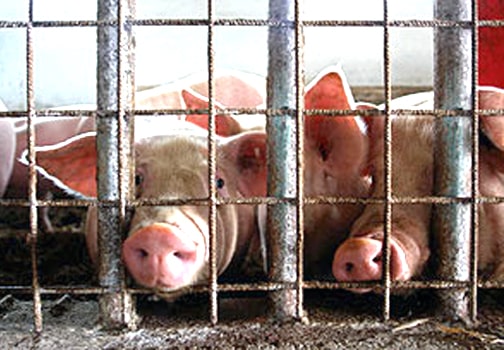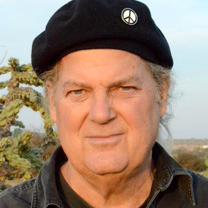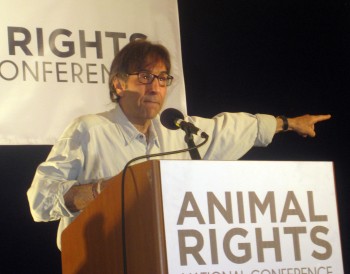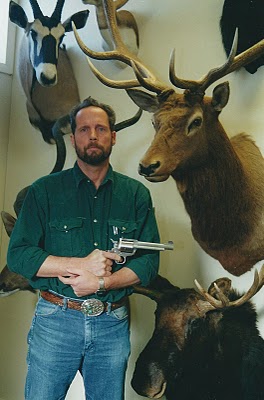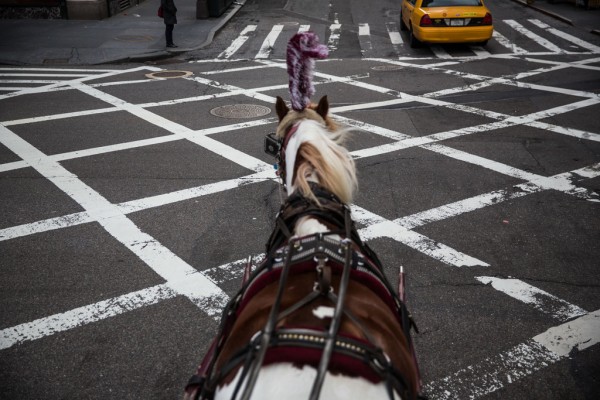
.
[I]f only Teddy could talk. Then we would know what he thinks of the politicians and activists and drivers who argue about his future. He could expound on Manhattan traffic, its pollution, the cold, the heat, the hay and the shrieking girls clutching dolls who pet his nose on Grand Army Plaza.
Teddy is 11 years old, a Percheron-cross draft horse from Pennsylvania’s Amish country — a pinto with a coat the color of warm cocoa and whipped cream. He has blinders on. But even those in the know cannot foresee how long it will take for Mayor Bill de Blasio to fulfill his campaign promise to banish the Central Park carriage horses as his first legislative act.
The City Council, now led by the sponsor of a 2010 bill to ban horse-drawn carriages, Melissa Mark-Viverito, has yet to discuss the issue.
Activists who want to end the carriage-horse trade contributed more than $1.3 million to help elect Mr. de Blasio and council members who supported a ban with a solution: Replace all the horses with a fleet of antique-styleelectric cars to serve tourists, not just in Central Park, but all over the city.
The American Society for the Prevention of Cruelty to Animals has applauded the mayor for his stance. “The A.S.P.C.A. does not oppose horses working,” said Matthew E. Bershadker, the organization’s president. “We oppose horses pulling carriages in New York City. These horses are surrounded by buses, cabs and traffic. We believe that it no longer is, or never was, quaint or romantic.”
Fighting for survival, the Horse and Carriage Association of New York is working with the Cavalry Group, an animal-owners’ rights group. It has put up a website and thrown open stable doors to scrutiny.
Cornelius Byrne, 66, whose stable on West 37th Street houses 17 horses, said the industry cannot seem to win. “We can say forever that we take care of them,” Mr. Byrne said. “And these animal activists, they seem to be able to say, ‘No, you don’t.’ It goes on forever, this argument: ‘Are the horses happy?’ ”
Amid bitter accusations and assumptions from both sides, Teddy goes to work.
“You guys want a ride?” Teddy’s driver, Angel Hernandez, 28, casually asked passers-by last Sunday from the hack line on 59th Street, across from the Plaza Hotel.
Twenty minutes and $50 later, Mr. Hernandez was snapping pictures of a mother and daughter from London, who had arrived at Kennedy Airport at 2 p.m., dropped their bags at their hotel and come straight to the carriages.
“Ban them?” the mother, Lesley Fabri, 60, exclaimed after her ride. “That’s the whole reason we’re here!”
She came, she said, because she was enchanted by the scenes in the Robert Redford movie “Barefoot in the Park,” while her 25-year-old daughter, Nadia, was drawn by the carriages on the “Real Housewives” reality series. The women planned to return for a night ride.
Opponents of the carriage horses say that the industry is romanticism run amok. Drivers, stable owners and stable hands call it a career.
“I don’t think Bill de Blasio knows what he’s doing,” Mr. Hernandez said softly on Sunday, after watching a toddler grin with delight from petting Teddy. “Their main point is that we abuse the horses. At the end of the day, I make sure he’s O.K. first,” he said, nodding to Teddy, “and then I go home. That’s not abuse.”
Teddy works about nine hours on alternate days, Mr. Hernandez said, which includes the 20-minute commute from the Clinton Park Stables on West 52nd Street between 11th and 12th Avenues. At 9:20 a.m. that Sunday, with his white-and-magenta bridle plume bobbing, Teddy clip-clopped to the park, passing the showrooms of Mercedes and Mini.
Mr. Hernandez and Teddy had eight fares for the day, excellent for a post-holiday Sunday. Waiting on the hack line, Mr. Hernandez fed Teddy oat pellets and corn, and allowed tourists to feed Teddy carrots. He gave Teddy a manicure of sorts, applying black polish to his hooves. The front left hoof bore his number: 3527.
Mr. Hernandez himself earns $10 for every 20-minute ride, and $20 for the less common 40-minute rides that cost $90. He keeps whatever tips he gets. The rest he gives to Teddy’s owner, Angelo Collura.
Mr. Hernandez first rode horses as a child on his grandmother’s farm outside Mexico City. He came to New York as a teenager and worked for nearly five years as a stableman before studying to become a driver like his uncle. He and his wife, who works in a restaurant, live in the Bronx with their two children. After work, he goes to school to become an electrician.
“It’s hard to get another job,” Mr. Hernandez said, wearing faux-diamond studs in both ears. “It’s not like if I leave this, I’ll grab another job right away.”
Mr. Hernandez is one of 150 drivers operating 220 registered horses for 68 carriage medallions. The proposed ban would require the owners to relinquish their horses to rescue farms with the promise the horses would never work again.
“They are all bred to pull; their main and sole purpose is to pull,” said Stephen Malone, an owner, driver and spokesman for the carriage association.
Mr. Malone has been driving horses in the city for 26 years; his father did it before him. He is galled that an activist group is telling him he cannot run his business and then offering an alternative, the electric car, that could cost him $150,000 to buy outright.
“It’s an elitist class battle that we’re fighting,” Mr. Malone said. “If the bill passes we’ll have no choice but to take legal action.”
But Mr. de Blasio and Ms. Mark-Viverito have said the horses no longer have a place in New York.
“It’s over,” Mr. de Blasio said two days before taking office. Last week, Marti Adams, a spokeswoman for him, said, “The administration is looking at the most effective way to ban horse carriages, whether legislatively or other routes, and will move forward in the coming weeks.”
“It’s long past time we end these practices which treat the horses so cruelly,” Ms. Mark-Viverito said in a statement last week.Edita Birnkrant, the New York director of Friends of Animals, likened the horses’ working conditions to prison.
“They are shackled into their carriages, pulling through streets of a chaotic unnatural environment and go back to their cells,” she said. “They need the ability to graze and roam freely. They never get that in New York. They live a life of total confinement, day after day.”
Mr. Malone counters that the horses get their exercise by pulling in the park. And while they do not get to graze daily, horses take a mandated vacation to a farm for no less than five weeks each year. In 2010, the Council enacted legislation to improve the horses’ working conditions and increase drivers’ pay.
Horses are not allowed to work in temperatures below 18 degrees and above 90, but that does not factor in wind chill, humidity or pavement temperature. Their stalls must be at least 64 square feet. At all four carriage horse stables in Manhattan, each stall has a rubber mat and an inspection certificate, citing recent veterinary checkups. There are sprinklers in all the stables, fans and water hoses for drinking.
Dr. Harry Werner, a veterinarian in North Granby, Conn., and a past president of the American Association of Equine Practitioners, said he was asked by the carriage horse association to make an assessment of the horses’ working conditions in February 2010. Dr. Werner said that he and three other veterinarians paid their own expenses to observe four of the five stables then in operation.
“Based on that inspection, I found no evidence whatsoever of inhumane conditions, neglect or cruelty in any aspect,” Dr. Werner said last week, adding that he does not take a position on carriage horses. “The demeanor of the horses was, to a one, that of a contented horse.”
“What happens is that people anthropomorphize,” he said. “They see a circumstance where they wouldn’t want to work in it, and think a horse wouldn’t work in it.”
Mr. Hernandez said he takes his cues from Teddy. If he does not want to work that day, his head will be down. In that case, Mr. Hernandez would take out Shaggy, 18, another horse owned by Mr. Collura. The owner’s third horse, Rocky, also 18, has been on extended vacation for the last six months in Pennsylvania.
The city’s Department of Health and Mental Hygiene monitors horse furloughs.
The A.S.P.C.A., until Jan. 1, had been the primary agent responsible for enforcement of animal anti-cruelty laws. But its 18 officers were cut to four, and the Police Department has taken over enforcement. A driver was arrested in December for overworking an injured horse, who was shown to have thrush, a common hoof infection.
Since 2011, there have been seven reported incidents involving horses: two collapsing and one dying, two getting spooked, and two involved in accidents with a taxi and an S.U.V.
Opponents cite these occurrences as evidence that the industry cares more about money than the animals. Stephen Nislick, who retired in 2012 as chief executive of the real estate company Edison Properties, founded the anti-carriage horse group NYClass, (New Yorkers for Clean, Livable and Safe Streets) in 2008, along with Ed Sayres, a former president of the A.S.P.C.A. Although a frequent critic of the stables, Mr. Nislick has not visited them. From seeing pictures, he said, he could tell the stalls were inadequate for sleeping and turning around, and that he believes the majority of the drivers and owners are only interested in working their horses.
“Do they care? Some of them care,” Mr. Nislick said. “Do the preponderance of them care? No. Can it be regulated? No.”
“It has nothing to do with horses,” said Kieran Kelly, 47, as he started his day at the Clinton Park Stables on West 52nd Street, sidestepping a pedicab driver from the garage next door. “It’s about politics.”
That two of the four stables happen to be sitting on prime real estate across from the Jacob K. Javits Convention Center, near the Hudson Yards development, does not seem to be a coincidence to their owners.
Mr. Nislick and Wendy K. Neu, the chief executive of a real estate and recycling firm and an active NYClass board member, were major contributors to New York City Not For Sale, or NYCN4S, a group that spent $1,141,305 from April to August last year to oppose the mayoral candidacy of Christine C. Quinn. Ms. Quinn did not support a ban of the carriage horses. NYClass also contributed to NYCN4S’s campaign, and provided volunteers to the anti-Quinn effort.
The A.S.P.C.A. gave $50,000 to NYClass in the last year, records show. Mr. Bershadker, the A.S.P.C.A. president, said that the money was a grant earmarked for electric car research.
NYClass spent $202,225 in the four days before the primary in September, state campaign finance records show.
Mr. Nislick and Ms. Neu, who had supported Ms. Quinn in 2009, instead backed Mr. de Blasio.
“There’s so many people out there that do care about these issues and do see the connection between how we treat animals and how we treat people,” Ms. Neu said.
Mr. Nislick insisted that he was not after the stable owners’ real estate. The issue, he said, was the horses.
NYClass has paid $475,000 for Jason Wenig, a car designer based in Florida, to create a prototype for an antique-style car. It won’t be ready until the end of April, Mr. Nislick said, adding that it could be until the end of the year before his group finds space to build the cars in the city. Depending on how fast 68 cars could be rolled out, the horses would be phased out if a ban is passed.
Where the horses would go is the elephant in the room. “We will personally guarantee the rescue of any remaining horses,” Mr. Nislick said.
Owners like Colm and Ian McKeever, who are brothers, recoil at the prospect of giving their horses to the very entity that wants to abolish their business.
“It is excruciatingly expensive to keep a retired horse,” said Dr. Lisa A. Fortier, a professor of large animal surgery at Cornell University’s College of Veterinary Medicine. She also warned that some horses could end up being slaughtered. “A lot of those farms are closing down,” she said, “and that’s a lot worse fate than walking in New York City.”
Wayne Pacelle, the president of the Humane Society of the United States, said that his organization would place 40 to 50 of the 220 horses in sanctuaries. “It will be a challenge,” he said, “but it’s finite. If you continue the carriage-horse industry you have horses, for an indefinite time, being cast off and put at risk.”
At a farm in Oxford, N.J., Mr. Nislick keeps a former carriage horse, Chance, which he bought from a rescue farm in 2008 through a private investigator. Mr. Nislick, 69, said because of mistreatment during its working life, the horse had founder, a serious hoof condition, when he got it, and was going to be killed. However, the owner of the rescue farm, Christy Sheidy, said the horse had not been injured and was not in danger of being put down.
Some weekends, anti-carriage horse protesters shout expletives at the drivers in the hack line. On Sunday, they were missing. Instead, children and their parents celebrated birthdays and couples kissed in coaches after springing for the too-brief, but tranquil, ride.
A gaggle of eight girls, who took a stretch limousine in from Long Island for a 10th-birthday party, took rides before heading to the American Girl store nearby. When told the horses may go away, 9-year-old Sydney Lazare shook her head. “That is awful,” she said, indignantly, “What kind of a world is this?”
Another friend shrugged and said, “Can we go back to the limo now?”
Piper Augut, 10, from Yarmouth, Mass., had chosen Teddy because of her love for spotted horses. As the carriage turned off Avenue of the Americas into Central Park, Mr. Hernandez told Piper and her parents about movie scenes filmed there (“Home Alone 2,” “Love Story”).
Teddy passed the charging stations for the park’s hybrid vehicles.
The only thing that seemed to bother Teddy during nine hours of work on Sunday was when his stablemate tailgated him on 55th Street. He jerked the reins.
It was just before 6 p.m. when he pulled into the stable. Mr. Hernandez and a stableman unfastened the carriage. As soon as Mr. Hernandez took off the harness and bridle, Teddy bounded down the hallway to his stall and went straight for the hay. He was home.
Correction: January 26, 2014
An article last Sunday about the battle over New York’s carriage horse industry quoted incorrectly from comments by an activist who wants to see the trade banned. The activist, Edita Birnkrant, called the horses’ environment a “chaotic, unnatural environment,” not a “chaotic natural” one. The article also misspelled the surname of a former president of the American Society for the Prevention of Cruelty to Animals. He is Ed Sayres, not Say
